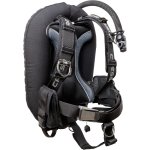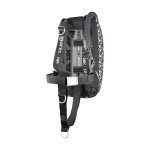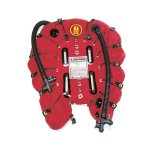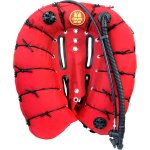Shop by Category
Info
BC/BCD Wings show info...
Confused by the different brands?
All of the modular backplate and wing systems we sell are modular, and will work when mixing between component brands. Just because you have a particular brand of backplate doesn't mean you need to buy the same manufacture harness and wing. Different manufacturers each have their own features and selling points, and like everything there are pros and cons which matter differently to different divers.
Tech Tip:
Will back inflation float an unconscious diver face up?
We usually hear this from divers who have always worn a jacket style BC, and we'd like to point out that it's irrelevant. It's true, that boating regulations require an approved wearable Personal Floatation Device (PFD) to float the unconscious victim face up in the water. But a Buoyancy Control Device (BCD) for scuba divers is not designed to be a PFD for an unconscious boating accident victim, regardless if the BC is jacket or back inflation.
We offer back inflation style options because experienced divers have learned the back inflation BCD is better than a jacket BCD, offering very precise control of buoyancy and trim as well as offering a more streamlined profile. An improperly fitted back inflation BCD might cause you to tip forward, but a properly fitted back inflation BCD, worn with a crotch strap, will allow you to assume and hold any position under the water, or on the surface.
When on the surface, divers new to back inflation will need to break the habit of holding down the power inflator until they feel squeeze (there won't be any), or hear the OPV release. With an over inflated air cell they will have a huge amount of buoyancy on their back, causing them to float too high in the water and tip forward. Instead, they should add only enough gas until their head is just above the water.
Finally, a very common error when selecting a back inflation BCD is to choose an buoyancy aircell (called a 'wing') that is much too big, causing a 'taco effect' that makes managing buoyancy considerably more difficult. The cylinder size, type and configuration, not lift capacity, is the best guide to selecting the correct wing. While many doubles wing designs can be adjusted for occasional use with singles, keep in mind they are not designed to be used primarily as singles wings and they are not optimal with singles. Unless you are diving one of the very large steel cylinders, a 30 lb (14 kg) is about the maximum lift you need for single tank sport diving.
Search Our Product Range

Dolphin Tech 65lb Lift Dual Bladder Twin Cylinder Wing

Dolphin Tech 50lb Lift Single Bladder Twin Cylinder Wing

Mares XR Donut Bladder Twin Tank Wing - 24KG 53LB
Max: 1

Apeks WTX-D60 Donut Wing - Twin Cylinder
-8%
Max: 2

Mares XR Donut Bladder Twin Tank Wing - 20KG 44LB
Max: 1

Dolphin Tech 30lb Lift Single Bladder Single Cylinder Wing

Cressi Aquawing Plus BCD - Rear Inflation
-10%

Dolphin Tech 40lb Lift Single Bladder Single Cylinder Wing

Cressi Aquawing BCD - Rear Inflation
-10%

Apeks WTX-D40 Donut Wing - Single Cylinder
-8%

Apeks WTX-D18 Donut Wing - Single Cylinder
-8%

OMS Single Bladder, Single Cylinder BC Wing - 32 lb Lift

Mares XR Polgygon Special Edition Donut Bladder Wing - 16KG

Mares XR Donut Bladder Single Tank Wing - 16KG 35LB

Mares XR Donut Bladder Single Tank Wing - 10KG 22LB

OMS Tesseract Dual Bladder Wing with Retraction Bands 60lb Lift

OMS Trieste Dual Bladder Wing - Retraction Bands 60lb Lift

Apeks WTX-D30 Donut Wing - Single Cylinder
-8%


























